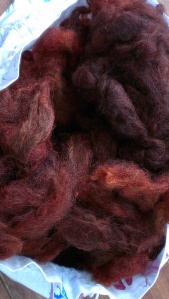I have a lot of Polwarth fleece, both brown and variegated white/tan. All of it gifted from pet sheep that live nearby. It is a privilege and it is also a difficulty. Washing fleece so fine and so greasy has been intimidating as well as slow. I have spun some in the grease, and washed some twice, and tried several different washing approaches. I have dyed and spun and spun and dyed. Two and three ply, corespun. you name it! I spun and knit an entire cardigan from naturally brown Polwarth, too.
And then one day someone at Guild said “I hate fine fleeces!” in my hearing, and it occurred to me that I do not have to spin it for the rest of my life. I lashed out and bought a considerable quantity (3.5 kg) of grey Corriedale (nothing to approach the stash of Polwarth, mind you) and it has been heavenly. I love grey fleece, and this is the loveliest corriedale I’ve ever had the pleasure to spin.
I have been dyeing it with eucalypt leaves and bark. I have oranges of many shades from rust and brick to flame to gentle sunset.
I have burgundy and plum.
And I also have some tans and walnuts. It appears I collected some bark that wasn’t exactly what I thought I had collected. But to be honest, I think these are lovely additions in this context. I’ve begun spinning yarns of many hues, chain plying to maintain the colour contrasts. Lovely. It’s hard to believe I can find these colours through combining bark and hot water and time with wool.
Now… I have figured out that what I would really like to do with at least some of this wool is knit a particular cardigan. And my beautful 3 ply yarn is too thick to make gauge for it! Possibly also for the design I have in mind those colour changes will not be ideal. So, I am about to embark on two ply yarns. This is my Tour de Fleece project.




WOW!
The colors you produced from the eucalyptus bark are simply astonishing!
I am drooling!
And maybe coveting too!
🙂
LikeLike
Thanks so much! I really appreciate your compliments!
LikeLike
Oh my gosh..those colors are just amazing!!
LikeLike
Thanks, Leah! I am really happy with them, and sorry I have run out of my favourite bark until it sheds again later in the year.
LikeLike
Just beautiful … clever nature and clever dyer and spinner and knitter and and ……
LikeLike
Ohh! Big blushing here 🙂
LikeLike
Absolutely extraordinary colours …. I am in awe …. the wool sure is doing some blushing too …. keep doing and sharing
LikeLike
Thanks Lili! That was my 100th post and I didn’t expect to blog this long or like it so much. The little cheer squad in the comments is one of the unforeseen delights 🙂
LikeLike
I must add my compliments as well. Your colors are absolutely stunning! Eucalyptus is not native to my area but seeing your work makes me want to plant a tree in my yard! Beautiful, beautiful!
LikeLike
Thanks so much, Pallas! Maybe you can find them planted as ornamentals in your area… you need a big yard for most Eucalypts!
LikeLike
I would love to try this technique since I have a fleece I’m about to finish carding. Does it have to be a specific kind of Ecalyptus? And more importantly does it have to be fresh? I live in the US and may not be able to get the freshest samples.
LikeLike
Hi Kelly, You will get some colour from most kinds of eucalyptus, but the colour varies a good deal. It is easier to get a clear leaf print from a leaf that is fresh (because it is flexible, apart from anything else), but you can get prints from dried eucalypts too. You might consider looking for ‘silver dollar’ (E Cinerea) and red ironbark (E Sideroxylon). These are varieties that can give orange to red that I hear of other dyers in the US using. I have heard of people finding them in florists, planted in their area, or from Trader Joe’s (dried)–no idea what kind of shop that is or why they sell them 🙂 US dyers are also using indigenous plants with this technique. good luck! Mary
LikeLike
Gorgeous colours!
LikeLike
Thankyou!
LikeLike
Pingback: Just in time for summer! | Local & Bespoke
I agree with everyone else who has commented, these colours are just gorgeous. Just wondering, how did you get the burgundy and plum?
LikeLike
Hello Heidi, that result is a combination of species choice, concentration of dyestuff relative to fibre, long processing and acidity. It is helped along by starting with grey fibre. You might find this post on seeking red worthwhile reading. This one about dyeing that grey fleece might be interesting to you too. all the best, Mary
LikeLike
Thank you Mary, those posts are great. It’s such a fascinating dye, isn’t it? So many variables to play with. I am envious that you have such a variety of them in your part of the world! I planted a Eucalyptus gunnii in a pot this year, and I am debating whether to give it a prune now or wait until the spring (the latter is probably wiser if I have the patience to wait until then). After reading your posts I will definitely give grey wool a go. And I am glad I read in your post that you have used unmordanted wool with Eucalyptus, I didn’t know that mordanting is not necessary.
LikeLike
I love not needing to use a mordant–simpler, quicker and no need for alum and all. I really am spoiled for choice living in the land of eucalypts, you’re right!
LikeLike
Pingback: More joy of stranded colourwork knitting | Local & Bespoke